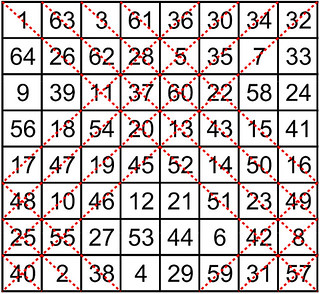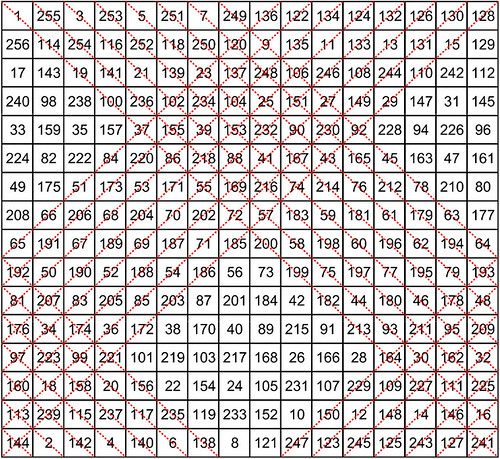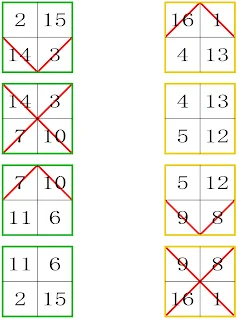![Title from "Divers ouvrages de mathematique et de physique / par Messieurs de l'Académie Royale des Sciences [M. de Frénicle ... et al.]."](https://blogger.googleusercontent.com/img/b/R29vZ2xl/AVvXsEjo3W591dPKzco_JXGVEqhLEIyPg1EE2L8zOKwhq6-2S1lDzLUw-MoGpuc7vH0EvFRMbwL64gw_wNuHdWIs8uLuig76jtYJ73jua59fqqF_dgU6A9d0mnMlLPnSSUZ_dWM8bjoWcvEG4jU/s320-rw/DES-QUARREZ-OU-TABLES-MAGIQUES_og.png) |
| Title of Frénicle's study of magic squares published in 1693 |
 |
| The "Table Générale des Quarrez Magiques de Quatre" published in 1693 |
Magic Squares offer partial glimpses of the convex or concave number systems that they represent. Analysed using modular arithmetic, Magic Tori open new perspectives.
![Title from "Divers ouvrages de mathematique et de physique / par Messieurs de l'Académie Royale des Sciences [M. de Frénicle ... et al.]."](https://blogger.googleusercontent.com/img/b/R29vZ2xl/AVvXsEjo3W591dPKzco_JXGVEqhLEIyPg1EE2L8zOKwhq6-2S1lDzLUw-MoGpuc7vH0EvFRMbwL64gw_wNuHdWIs8uLuig76jtYJ73jua59fqqF_dgU6A9d0mnMlLPnSSUZ_dWM8bjoWcvEG4jU/s320-rw/DES-QUARREZ-OU-TABLES-MAGIQUES_og.png) |
| Title of Frénicle's study of magic squares published in 1693 |
 |
| The "Table Générale des Quarrez Magiques de Quatre" published in 1693 |
 |
| 1/4 pandiagonal squared matrix of an associative magic square viewpoint of an order-12 semi-pandiagonal magic torus |
Magic squares have fascinated mathematicians for centuries and they continue to do so today. However, many questions remain unanswered, and this study proposes a different perspective in order to shed new light on what magic squares are and how they work. Considering magic squares to be flattened partial viewpoints of convex or concave magic tori, the implied Gaussian surfaces require a modular arithmetic approach that is tested and analysed here.
Until today, most magic square construction methods use base squares, whilst "Magic Torus Coordinate and Vector Symmetries" proposes modular coordinate equations that not only define specific magic tori, but also generate their magic torus descendants.
The construction of Agrippa's traditional magic squares is analysed in detail for each of the seven planetary magic tori, and modular coordinate equations are defined that generate descendant tori throughout the respective higher-orders, whether they be odd, doubly-even, or singly-even.
The unique third-order magic torus and also a fifth-order pandiagonal torus of Latin construction are examined in detail. The modular coordinate equations that are defined generate an interesting variety of higher-odd-order descendant tori.
The study also explores the construction of the 12 different types of fourth-order magic tori, as well as the generation of their doubly-even magic torus descendants. In addition, a fourth-order Candy-style perfect square pandiagonal torus, and a fourth-order unidirectionally pandiagonal semi-magic torus, are each analysed in detail, and their torus descendants generated, throughout their respective higher-orders.
At the end of the study observations are made, and some conclusions are drawn as to the signification of the findings, and the potential for future research.
Some sample illustrations of a fourth-order partially pandiagonal torus and its partially pandiagonal torus descendants are shown below:
 |
| T4.195 4th-order partially pandiagonal torus |
 |
| 8th-order partially pandiagonal torus, direct descendant of T4.195 |
 |
| 12th-order partially pandiagonal torus, direct descendant of T4.195 |
 |
| 16th-order partially pandiagonal torus, direct descendant of T4.195 |
To download "Magic Torus Coordinate and Vector Symmetries" from Google Drive, please use the following link: MTCVS 161019. The 134 Mo pdf file exceeds the maximum size (25 Mo) that Google Drive can scan, but as the file is virus free you can download it safely. Depending on the speed of your computer, the download can take up to two or three minutes to complete.

 |
| Magic diagonal sequences on the Magic Torus Type T4.01.1 (index n° T4.194) |

Further to my last article (published on the 26th March) Harry White has kindly run a computer programme to verify and validate my hypothesis: The 4th-order magic tori are indeed totally covered by sub-magic 2x2 squares.
As Harry White's results gave 7,712 sub-squares for the 880 Frénicle squares it was necessary to determine which tori had a reduced cover of sub-magic squares. After verification I have found that there are two families of the type 2 and type 5 tori. My latest results and totals are given below. It could be that by using observation and manual input I have overlooked something. Your comments are always welcome.
 |
| 4th-order panmagic or pandiagonal torus type 4.01 represented by Frénicle index 102, Dudeney type I |
 |
| 4th-order panmagic or pandiagonal torus type 4.01 represented by 16 sub-magic 2x2 squares |
 |
| 4th-order semi-panmagic or semi-pandiagonal torus type 4.02.1 represented by Frénicle index 016, Dudeney type VI |
 |
| 4th-order panmagic or pandiagonal torus type 4.02.1 represented by 12 sub-magic 2x2 squares |
 |
| 4th-order semi-panmagic or semi-pandiagonal torus type 4.02.2 represented by Frénicle index 021, Dudeney type II |
 |
| 4th-order semi-panmagic or semi-pandiagonal torus type 4.02.2 represented by 8 sub-magic 2x2 squares |
 |
| 4th-order partially panmagic or partially pandiagonal torus type 4.03 represented by Frénicle index 046, Dudeney type VI "Simple" |
 |
| 4th-order partially panmagic or partially pandiagonal torus type 4.03 represented by 8 sub-magic 2x2 squares |
 |
| 4th-order partially panmagic or partially pandiagonal torus type 4.04 represented by Frénicle index 040, Dudeney type VIII "Simple" |
 |
| 4th-order partially panmagic or partially pandiagonal torus type 4.04 represented by 4 sub-magic 2x2 squares |
 |
| 4th-order basic magic torus type 4.05.1 represented by Frénicle index 002, Dudeney type VI Simple |
 |
4th-order basic magic torus type 4.05.1 represented by 8 sub-magic 2x2 squares |
 |
| 4th-order basic magic torus type 4.05.2 represented by Frénicle index 003, Dudeney type XII Simple |
 |
| 4th-order basic magic torus type 4.05.2 represented by 4 sub-magic 2x2 squares |
Each number of a fourth-order magic torus (or magic square) comes from at least one 2x2 sub-magic square. Or, expressed otherwise, the surface of every fourth-order magic torus is entirely covered by 2x2 sub-magic squares. This hypothesis has since been confirmed by Harry White's computer skills (see above).
The table below is a new résumé of the different 4th-order magic tori taking into account the different arrangements of the sub-magic 2x2 squares that cover them.